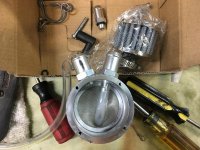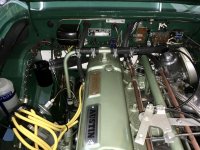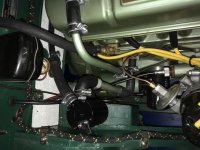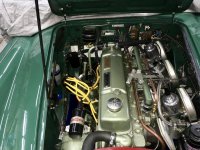Follow up:
Finished up the plumbing yesterday and started the car this morning. At first i did not think i had any vacuum at the oil filler cap but then realized you had to hold your hand there a few seconds to allow the vacuum to build. i am not sure how much vacuum i should get but it was a substantial amount, well it seemed like to me. you can definitely hear the suction if you pull the oil cap off. Since this is manifold vacuum, and not ported, i would guess i should have good vacuum at idle.
Speaking of which:
idle. i did not have any trouble with lumpy idle or uneven idle. in fact it may have been a little smoother. i did feel like the idle was now higher than before. but then i have fought the linkage allowing the idle to come down since i have put the engine in. So this cold day may have been part of the issue. after getting the car up to temperature, i did go back and balance the carbs again. i felt like adding the extra air into the front (tri-carb model) might thrown them off. i did have to add some throttle to the front carb to balance. but then i had to change the rear one a little also. So maybe i was just off from the last balancing act. I also have adjusted the mixture down one flat. We will have to get some runs in to check the plugs.
Oil Catch Can:
i did purchase an oil catch can. i bought it off of Amazon. i liked the way it seemed to work. on this can, there is an inner bit of tubing connecting to the inlet fitting. this tubing went down under a filter so all air had to go thru the filter and the air exiting is not going over any oil that may be collected. i did change the tube that was in the cannister. i have some 1/4 clear fuel line here and it felt more substantial than what was in the unit. And i wanted to make sure how far under the filter the tube went. did not want it so deep it could be in the oil it may collect. this can came with fittings for 5/8 hose and has a drain valve on the bottom. there is a plug on the top for a filter which i am not using. i figure every winter i can pull the plug and spray some cleaner down in there and drain it, which should keep the filter clean.
plumbing:
you can see in the pictures below i still ran a hose over to the rear carb. there is no air coming from that way. there is a "T" in the line and the side towards the carb is plugged. i did this to sort of keep an original look and to give the hose some support. the hoses run around behind the valve cover and over to the can on the left side. since the fitings were 5/8, this also allowed me to put the PCV valve behind the oil can.
View: all in it looks ok. i got the can in aluminum color but seemed like too much bling when mounted. i almost painted it the engine color but did not feel that would look right since the can is not attached to the engine. So i went black. small can, 2-1/2" dia and 3-1/2" tall.


So not sure i have the right vacuum? how much is enough or too much? i guess if i have vacuum and it idles/runs fine, i am good? be interesting to see if my oil leakage at the rear seal stops.
i felt like i was done (silly me) and ready to go. but on my last start to check the idle, the front carb starts to run gas out the overflow. guess i got something in that grose jet. i will pull it tomorrow and if it still does act right, i think i have a couple of needle valves. it's always something.....
Oh and a special thank you to whoever it was that suggested putting pins on those air breathers. that sure saves a lot of time and hassle.

 Hey there Guest!
Hey there Guest!
 smilie in place of the real @
smilie in place of the real @
 Pretty Please - add it to our Events forum(s) and add to the calendar! >>
Pretty Please - add it to our Events forum(s) and add to the calendar! >> 







 A friendly reminder - be careful what links you click on here. If a link is posted by someone you don't know, or the URL looks fishy, DON'T CLICK. Spammers sometimes post links that lead to sites that can infect your computer, so be mindful what you click.
A friendly reminder - be careful what links you click on here. If a link is posted by someone you don't know, or the URL looks fishy, DON'T CLICK. Spammers sometimes post links that lead to sites that can infect your computer, so be mindful what you click.